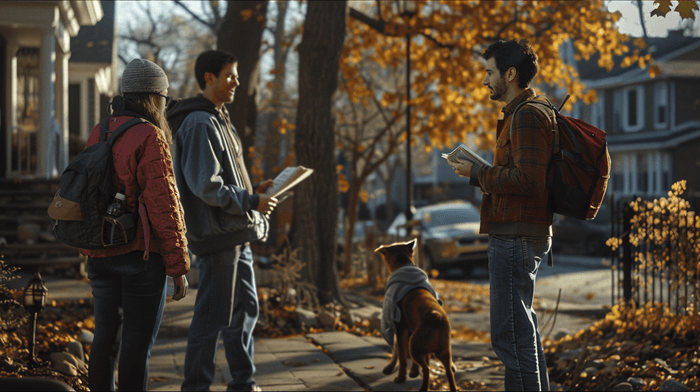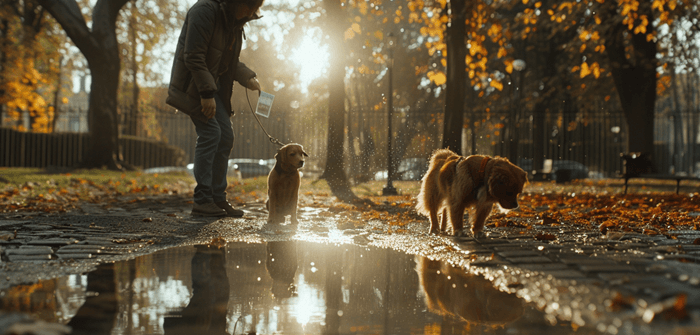
Losing a dog can be a terrifying experience for any pet owner. The panic, fear, and confusion that follows when a dog gets lost can make it difficult to think clearly, but staying calm and knowing what steps to take immediately will dramatically increase the likelihood of finding your dog safely and quickly. Every minute counts in these situations, and the right actions, taken at the right time, can make all the difference between a short search and a prolonged, stressful situation.
In this detailed guide, we will provide you with a comprehensive strategy to locate your lost dog as quickly as possible. We will walk through various approaches, including leveraging local resources, online communities, and advanced technologies like microchips and GPS trackers. By following these steps, you’ll ensure that you’re maximizing your chances of reuniting with your beloved pet in a timely manner.
We’ll cover:
- Immediate actions to take once you realize your dog is missing.
- Utilizing social media, community groups, and local resources to aid in your search.
- How to effectively create and distribute lost dog flyers.
- Common mistakes that owners make during their search and how to avoid them.
- The role of technology, including microchips and GPS trackers, in finding lost dogs.
- Backing everything up with scientific data and studies to ensure you have the best tools for success.
By the end of this article, you’ll have a clear, actionable plan to help bring your dog home safe and sound. Let’s dive in.
Why Acting Fast Is Critical When Your Dog Gets Lost
When a dog goes missing, time is one of the most critical factors. Acting quickly ensures that your dog remains within a manageable search radius, is less likely to face hazardous situations, and maximizes the effectiveness of your search efforts. Here’s why fast action is absolutely necessary:
1. Dogs Can Cover Significant Ground Quickly
Dogs are fast, and in a state of confusion or excitement, they may run far distances in a matter of minutes. Particularly in the early stages, dogs are likely to be highly mobile. Larger or more active breeds can cover miles in a short time, which makes the initial hours following their disappearance especially critical. Starting your search immediately will minimize the distance you need to cover.
2. Exposure to Dangerous Situations
While lost, your dog may wander into dangerous situations, such as busy streets, construction areas, or even wildlife territory, depending on your location. They could also encounter extreme weather conditions—heat, cold, or storms—that could pose additional risks. The quicker you act, the higher the chances are of finding your dog before they encounter harm.
3. Animal Control Could Pick Them Up
Many towns and cities have strict policies regarding stray animals. If your dog is seen wandering unattended, there is a chance that animal control may pick them up. While shelters are safe spaces, being transported to a shelter can delay the process of finding your pet, and some facilities are not equipped to hold animals long-term. Acting swiftly can help you avoid this situation altogether.
4. Mobilizing a Local Search Effort Takes Time
The sooner you start your search, the sooner you can get help from others. Whether it’s your neighbors, local businesses, or online communities, having multiple people looking for your dog increases your chances of success. The faster you alert others, the more effectively they can keep an eye out for your pet.
5. Memory Retention of Recent Sightings
People are more likely to remember seeing a dog that went missing within the past few hours than they are to recall something from a few days ago. By starting your search early, you’re capitalizing on fresh memories and the immediate availability of eyewitnesses.
Immediate Steps to Take When Your Dog Gets Lost
The initial moments after discovering your dog is missing are crucial. Here’s a step-by-step guide to the actions you should take immediately:
Step 1: Check Your Immediate Surroundings

Dogs often don’t stray too far at first, especially if they’re simply disoriented or exploring. Start by thoroughly searching the area where your dog was last seen. Walk or drive around the vicinity, calling your dog’s name calmly and bringing along their favorite treats or toys to lure them back. Dogs can sometimes be frightened by loud noises, so avoid yelling or shouting as this might cause them to run further away.
Tip: Dogs can hide in small, unexpected places. Look under cars, bushes, porches, and even inside open garages or sheds.
Step 2: Notify Local Neighbors Immediately
Informing your neighbors right away is key. The more eyes looking for your dog, the better your chances. Knock on doors, or send out a quick text to people in your neighborhood, asking if they’ve seen your dog and to keep an eye out.
Additionally, if your community uses neighborhood apps like Nextdoor, post about your lost dog there. Nextdoor alerts people who live in your immediate area, increasing the likelihood that someone nearby will spot your dog.
Step 3: Start Using Social Media

Social media is one of the most effective tools available to help you locate your lost dog. Create a public post with a recent photo of your dog, including their breed, size, color, any distinguishing features, and where they were last seen. Ask your friends and followers to share the post, and make sure to include contact information so anyone with information can reach you.
Suggested Platforms:
- Facebook: Join local groups dedicated to lost and found pets in your area. Most cities have Facebook groups where community members actively post about missing animals. Use relevant hashtags like #LostDog, #MissingPet, or #DogRescue along with your city’s name.
- Instagram: Share the same post to your Instagram feed and Stories, using similar hashtags to those on Facebook. Instagram’s visual nature makes it an excellent platform for sharing photos and updates.
- Twitter: Tweet about your missing dog and tag local news outlets, rescue organizations, and popular community accounts. The more people who see your post, the better.
Example Hashtags to Use:
- #LostDog
- #DogGoneMissing
- #MissingDog[YourCity]
- #FindFido
Tip: Make your post public to ensure maximum visibility.
Step 4: Call Local Shelters, Veterinarians, and Animal Control
Immediately contact every animal shelter, veterinarian, and animal control facility in a 10 to 20-mile radius. Provide them with detailed information about your dog, including their name, breed, size, and any unique markings. Many shelters have lost pet databases or will post your dog’s information on their website.
It’s also a good idea to physically visit local shelters and animal control offices. Ask to look through their kennels and leave your contact information. Be sure to follow up regularly, as dogs that are picked up by animal control don’t always end up at a shelter right away.
Step 5: Create and Distribute Flyers

Physical lost dog flyers are still highly effective, especially when placed in high-traffic areas such as parks, grocery stores, schools, and busy intersections. Here’s how to create an effective flyer:
- Use a clear, recent photo of your dog.
- Include the words «LOST DOG» in large, bold letters at the top of the flyer.
- Add a brief but specific description of your dog (color, breed, any unique features).
- Provide your contact information, including a phone number.
- Offer a reward if you can, as this might encourage people to take extra care in looking for your dog.
Place flyers in key areas, such as:
- Neighborhoods: Post flyers on community boards or light poles in residential areas.
- Parks: Dogs are often drawn to parks, so post flyers near entrances and playgrounds.
- Pet Stores and Veterinary Clinics: Many pet-friendly businesses are happy to display lost pet flyers.
Pro Tip: Laminate your flyers or put them in plastic protectors to shield them from the weather.
Step 6: Activate Your Dog’s Microchip or GPS Tracker
If your dog has a microchip, immediately contact the microchip company to report your pet missing. They can send out alerts to local shelters, veterinarians, and rescue organizations, and in some cases, they might even have a network of volunteers who will help search for your dog.
If your dog wears a GPS tracker on their collar, use the app associated with the device to try and locate their current whereabouts. This can give you real-time location data, making it one of the fastest ways to reunite with your dog.
Tip: If you don’t currently have a microchip or GPS collar for your dog, consider investing in one once they are found to prevent future issues.
Step 7: Organize a Search Party
Gather friends, family, and neighbors to help you search for your dog. Many hands make light work, and a coordinated effort will cover more ground faster. Assign each person an area to search, and ask them to bring treats, leashes, and toys to help lure your dog back if they find them.
Search locations should include:
- Parks and Trails: If your dog likes exploring nature, head to local parks and walking trails.
- Familiar Locations: Dogs often return to places they’ve been before, such as areas you frequent on walks or car rides.
- Nearby Businesses: Some dogs, especially social ones, may approach restaurants, cafes, or even gas stations, where people gather.
Step 8: Expand the Search as Time Goes On
If your dog isn’t found within a few hours, begin expanding your search area. Increase the radius of your search by several miles each day, checking places where dogs are likely to go, such as woods, open fields, or areas with water sources. This is especially important if you live in a rural area where dogs might roam far from home.
Common Mistakes to Avoid When Searching for Your Lost Dog

Even though searching for a lost dog is stressful, certain mistakes can reduce the likelihood of finding your pet quickly. Here’s what you should avoid:
Mistake 1: Waiting Too Long to Start Searching
One of the biggest mistakes people make is waiting too long to begin searching for their lost dog. As soon as you realize your pet is missing, start looking right away. Even if you think your dog may return home on their own, don’t rely on this possibility. The sooner you begin your search, the more likely it is you’ll find your dog.
Mistake 2: Not Using Enough Resources
Some owners focus on one or two methods of searching, like social media or calling shelters, and neglect others like posting flyers or contacting local animal control. Utilize every tool at your disposal to maximize your chances.
Mistake 3: Not Checking Back with Shelters
Many owners call a shelter once and assume that if their dog isn’t there, they’ll never be there. However, shelters receive new animals every day, and your dog could end up there later. Follow up regularly with shelters and rescues to ensure that they keep your contact information and are actively on the lookout.
Mistake 4: Using Inaccurate Descriptions or Photos
Be as detailed and accurate as possible when describing your dog. Use clear, high-quality photos, and list any distinguishing features. If your dog has a particular marking, limp, or collar color, make sure to include it.
Mistake 5: Underestimating How Far Your Dog Can Travel
Even small dogs can cover a surprising amount of ground when lost, particularly if they’re scared. Don’t limit your search area to just your immediate neighborhood—expand it as time goes on, and be sure to notify surrounding towns or cities as well.
Scientific Support for Lost Pet Recovery Methods
Research shows that a combination of immediate action, technology, and community involvement significantly increases the likelihood of reuniting with a lost dog. Studies conducted by the American Society for the Prevention of Cruelty to Animals (ASPCA) found that 93% of lost dogs were found when their owners took swift action, leveraging both digital tools and physical resources.
Microchips, in particular, have proven to be incredibly effective. A study by the Journal of the American Veterinary Medical Association revealed that dogs with microchips were returned to their owners 52.2% of the time, compared to just 21.9% of dogs without chips.
Social media has also become a vital tool in pet recovery. Platforms like Facebook and Instagram provide instant access to thousands of people, which is why experts encourage using them as part of a comprehensive search effort.
Conclusion: Take Action Now to Bring Your Dog Home
Losing a dog is a stressful and emotional experience, but taking quick, strategic action can dramatically improve your chances of finding them. By following the steps in this guide—starting with a thorough search of your immediate area, leveraging social media and local resources, and utilizing tools like microchips and GPS trackers—you can maximize your chances of being reunited with your pet as quickly as possible.
Remember to stay calm, stay positive, and never give up hope. Many dogs are found even after being lost for days or even weeks, so persistence is key. And once your dog is home safely, consider taking preventative measures, such as investing in a GPS tracker or ensuring your pet’s microchip information is up-to-date.
